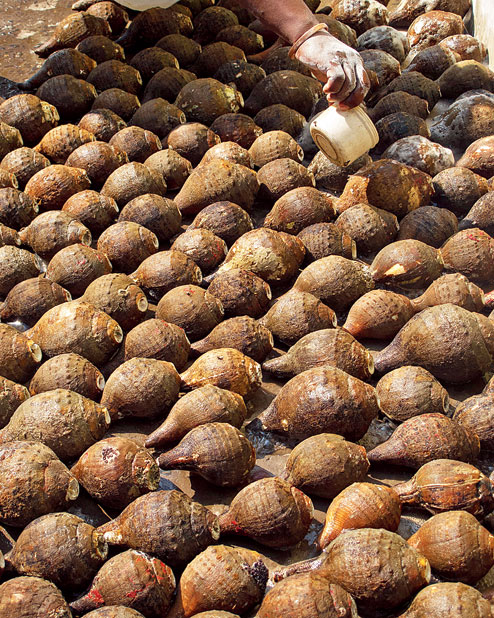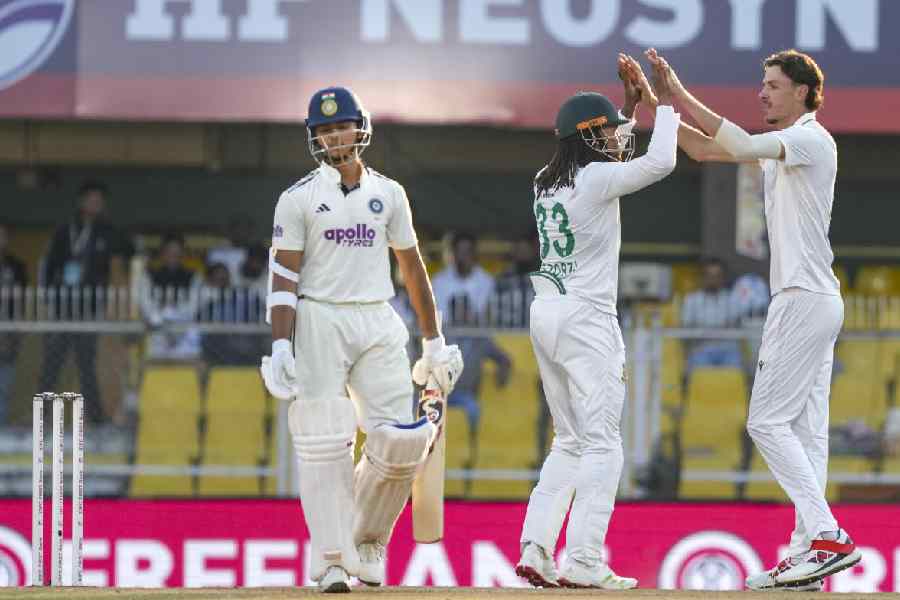


Ekhon hobe na, jaan jaan... jotto shob (Just go away. I don't have time for such nonsense)." The owner of the Dhaka Shankha Mandir showroom in north Calcutta's Barrackpore area shoos us away. We had made an appointment with the wholesale dealer and manufacturer of shankhas or conch shell bangles days in advance; we remind him, but he couldn't care less. "I am in no mood to talk to reporters. You will write a story about the disappearing craft. What will we get?"
Shankha is the milky white bangle that encircles the wrists of Bengali women. At one time, like the shindur, it was meant to indicate marital status. Today, it is just another piece of clunky tradition with few takers; a trend that has cost the shankharis, or conch shell artisans, dearly.

The angry man has a point, but suddenly, we are at a loose end. It is while loitering in the bylanes of the shell traders' colony that we come across Hemanta Sur. He is putting out to dry in the sun, brown conch shells in neat rows. He is reticent, but not entirely closed to conversation. Eventually, he offers us a seat and some tea in his "office".
Sur, like a lot of the other shankha craftsmen and traders in Barrackpore, has roots in Dhaka's Shankhari Bazaar, seat of the conch shell industry in pre-Independent India. After Partition, the majority of artisans migrated to West Bengal.

"In undivided Bengal, apart from Dhaka, the other clusters of conch shell craft were Rangpur, Faridpur, Pabna and Chittagong," says Sudipa Ray Bandyopadhyay, head of the department of Ancient History and Culture in Calcutta University. "In Bengal now, Bankura, Bishnupur, Murshidabad and Nadia are the shankha hubs."
Scotsman James Hornell, a marine biologist and superintendent of fisheries in Madras, did a real deep dive on the shankha. In 1914, he wrote a book, The Sacred Chank of India. European scholars usually refer to the shankha as "chank".

Hornell traced the use of the shankha back to the sixth century BC Pandyan kingdom. According to Hornell, this Hindu tradition was commonplace in southern, central and western India until the invasion of Mahmoud of Ghazni. He writes, "The cause of the cessation of the chank industry (and associated Hindu rituals) in the Deccan, Gujarat, and Kathiawar is to be looked for in the constant strife which kept India in a welter of blood through the six centuries of Muhamma-dan dominance in the land."
That may have been the case in those parts, but in Dhaka and Bengal the same tradition continued despite Muslim rule. Experts attribute this to the deeply embedded socio-religious loyalties for Shiva and Parvati (Durga), in these parts.

According to Bandyopadhyay, local lore links the shell to Shiva. The story goes that at the time of their wedding, Shiva, disguised as a shankhari, created for his bride the shankha out of his braided hair.
Sur, the shankhari, tells us that his clan originates from Shiva and Parvati. He refers us to Narayan Sen, who is chairman of a shell traders' guild in Barrackpore. Sen shares more such theories. Apparently, some craftsmen trace their roots to Vishwakarma, the god of craft and architecture, while others believe the seer, Agastya, crafted the "shankher karat" or " kush karat", the crescent-shaped tool used by artisans to slice circular rings out of the conch.

Hornell describes the shell slicing process thus: "...(it) calls for a highly trained eye, perfect steadiness of hand and arm, and an iron-like capacity to sit for long periods in a position of great discomfort. Unless in a perfect condition of bodily fitness, such work is an impossibility."
Sen takes us to the only surviving craftsman of Barrackpore who has worked on a kush karat - Baidya Nath Rakshit. The 85-year-old's eyesight is failing him, but not his memory. He recalls how he learnt the craft in a workshop in Dhaka. "I handled the kush karat for the first time when I was barely 12 or 13. You need strong hands and extreme focus. Lose your focus and the saw will slip and cut your heel," says the old man pointing to his wrinkled and scarred heels.
Rakshit's father, Braja Kishore Rakshit, was a shankhari and his father and grandfather before that. His family has actually been in the trade for choddo purush (14 generations). But his son, Debshankar, didn't take any interest in the craft, at least initially. He migrated to Gujarat to work in a metal sheet factory. "I saw how my father and grandfather suffered as the tradition dwindled," says Debshankar.
The usual suspects have failed the shankha tradition: government apathy, missing incentive, dwindling markets. "Initially the state handicrafts corporation, Manjusha, helped us procure raw shells at a subsidised rate, but now the wholesale trade is controlled by cartels in Tamil Nadu and central Calcutta."
Sebak Kumar Jana, associate professor of Economics with the rural development department of Vidyasagar University, has done a detailed analysis of the challenges faced by the trade. He studied 240 household units in four districts of Bengal in 2013. "An artisan works for an average of 10 hours a day in a dimly-lit room. He earns about Rs 6,000 to Rs 7,000 in a month, same as a lot of farm labourers. His sedentary job and the occupational hazard of inhaling shell dust make him vulnerable to chronic lung diseases," says Jana.
Shankha-making is extremely labour-intensive and tends to eat into the profits unless a pair is priced at Rs 700, or more. Artisans find it difficult to get bank loans and are heavily dependent on moneylenders even now. "To top it, since this is an unorganised family tradition, traders and craftsmen have no idea how to market or promote the item," says Jana.
Shankha may be a dying art and aesthetic on this side of the border, but in Bangladesh, it is very much a part of local culture and tradition.
It has a loyal following among the small Hindu community there. "Also, many Muslim women - especially teenagers and college-going girls - like to wear it as just another accessory," says Alam Khorshed, who runs an art complex and organises art festivals in Chittagong and Dhaka.
Dipak Nandy is a shell bangle artisan in Dhaka's Shankhari Bazaar. Talking to The Telegraph over a patchy phone line he says, "There's a demand here, especially during the wedding and festive seasons. But we don't have enough skilled craftsmen. Neither do we get raw conch shell from Chennai due to a trade embargo between India and Bangladesh."
Jana is hopeful that the governments at the centre and in the state will wake up to the issues. After all, unlike most traditional crafts, the shankha has found a worthy exponent or two among the newer generations.
Rakshit's prodigal son, Debshankar, has returned from Gujarat. He has used his knowhow on metal work to come up with an electric saw to replace the clumsy old karat. He is now a leading manufacturer of automatic tools used in the shankha industry.
Rakshit's grandson, college lad Umashankar, has also taken to crafting. He wants to export, set up an online shopping portal and maybe an app to sell shell bangles across the world.
Now, that's a plan.
PRIDED PAST
Shankhas are made from the conch shell, which comes from sea snails, in this case Turbinella pyrum
Harappa connection: Recent archaeological studies have discovered shell bangles in Harappan sites, pushing their origin back by another 2,000 years
10th century: That is when we find the earliest mention of bracelets and anklets carved out of conch shells and worn by women of Hindustan in Arab merchant Abu Zaid’s account
17th century: In French gem merchant and traveller, Jean-Baptiste Tavernier’s travelogue, there is mention of over 2,000 people employed in the shell craft industry in Dhaka, then known as Dacca, and Pabna.











